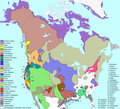Tập tin:Langs N.Amer.png

Kích thước hình xem trước: 661×600 điểm ảnh. Độ phân giải khác: 265×240 điểm ảnh | 529×480 điểm ảnh | 847×768 điểm ảnh | 1.129×1.024 điểm ảnh | 1.290×1.170 điểm ảnh.
Tập tin gốc (1.290×1.170 điểm ảnh, kích thước tập tin: 599 kB, kiểu MIME: image/png)
Lịch sử tập tin
Nhấn vào ngày/giờ để xem nội dung tập tin tại thời điểm đó.
| Ngày/giờ | Hình xem trước | Kích cỡ | Thành viên | Miêu tả | |
|---|---|---|---|---|---|
| hiện tại | 17:28, ngày 20 tháng 7 năm 2019 |  | 1.290×1.170 (599 kB) | Denniss | Reverted to version as of 21:52, 1 March 2009 (UTC) |
| 16:54, ngày 13 tháng 7 năm 2019 |  | 1.290×1.170 (840 kB) | Thylacinus cynocephalus | Having colonial borders on an indigenous language map is offensive | |
| 21:52, ngày 1 tháng 3 năm 2009 |  | 1.290×1.170 (599 kB) | Malus Catulus | optipng, pngout | |
| 14:31, ngày 22 tháng 12 năm 2006 |  | 1.290×1.170 (668 kB) | Mahahahaneapneap | pngcrushed | |
| 00:43, ngày 11 tháng 11 năm 2006 |  | 1.290×1.170 (916 kB) | Ish ishwar | update | |
| 04:55, ngày 1 tháng 4 năm 2006 |  | 1.296×1.176 (678 kB) | Locke Cole | smaller file (pngout /f0 Langs_N.Amer.png /b4096) / Change: -315546 bytes ( 68% of original) | |
| 04:01, ngày 7 tháng 1 năm 2006 |  | 1.296×1.176 (986 kB) | Ish ishwar | adai,chimariko = unclassified; adjust uto-aztec, salinan, southern athabasc., muskogean; + Isla Ángel de la Guarda, Isla del Tiburón, Lake Okeechobee | |
| 21:24, ngày 9 tháng 12 năm 2005 |  | 1.318×1.195 (714 kB) | Ish ishwar | checker grid pattern to Chumash | |
| 06:12, ngày 6 tháng 12 năm 2005 |  | 1.318×1.195 (714 kB) | Ish ishwar | forgot seri, fix fam key | |
| 01:21, ngày 6 tháng 12 năm 2005 |  | 1.318×1.195 (712 kB) | Ish ishwar | update |
Trang sử dụng tập tin
Có 2 trang tại Wikipedia tiếng Việt có liên kết đến tập tin (không hiển thị trang ở các dự án khác):
Sử dụng tập tin toàn cục
Những wiki sau đang sử dụng tập tin này:
- Trang sử dụng tại af.wikipedia.org
- Trang sử dụng tại an.wikipedia.org
- Trang sử dụng tại ar.wikipedia.org
- Trang sử dụng tại azb.wikipedia.org
- Trang sử dụng tại az.wikipedia.org
- Trang sử dụng tại bat-smg.wikipedia.org
- Trang sử dụng tại be-tarask.wikipedia.org
- Trang sử dụng tại beta.wikiversity.org
- Trang sử dụng tại be.wikipedia.org
- Trang sử dụng tại bg.wikipedia.org
- Trang sử dụng tại br.wikipedia.org
- Trang sử dụng tại ca.wikipedia.org
- Trang sử dụng tại ca.wikimedia.org
- Trang sử dụng tại cs.wikipedia.org
- Trang sử dụng tại cv.wikipedia.org
- Trang sử dụng tại da.wikipedia.org
- Trang sử dụng tại da.wikibooks.org
- Trang sử dụng tại de.wikipedia.org
- Trang sử dụng tại dsb.wikipedia.org
- Trang sử dụng tại en.wikipedia.org
- History of the Americas
- North America
- Native Americans in the United States
- First Nations in Canada
- Linguistics and the Book of Mormon
- Lower Rio Grande Valley
- User:Ish ishwar
- Classification of the Indigenous languages of the Americas
- Wikipedia:Featured pictures thumbs/03
- Indigenous peoples of the Americas
- Wikipedia:Wikipedia Signpost/2005-12-26/Features and admins
- Wikipedia:Featured picture candidates/December-2005
- Wikipedia:Featured picture candidates/Indigenous language families north of Mexico
- User:Cyde/Featured pictures
- Talk:New World
- Wikipedia:Picture of the day/April 2006
- Wikipedia:POTD/April 1, 2006
- Wikipedia:Picture of the day/April 1, 2006
- Wikipedia:Today's second feature/April 1, 2006
- Portal:North America/Selected picture
- User talk:Wapcaplet/Archive 3
- Wikipedia:POTD column/April 1, 2006
- Wikipedia:POTD row/April 1, 2006
Xem thêm các trang toàn cục sử dụng tập tin này.
Đặc tính hình
🔥 Top keywords: Đài Truyền hình Kỹ thuật số VTCTrang ChínhGiỗ Tổ Hùng VươngTrương Mỹ LanĐặc biệt:Tìm kiếmHùng VươngVương Đình HuệUEFA Champions LeagueKuwaitChiến dịch Điện Biên PhủFacebookĐài Truyền hình Việt NamTrần Cẩm TúĐội tuyển bóng đá quốc gia KuwaitGoogle DịchViệt NamCúp bóng đá U-23 châu ÁCúp bóng đá U-23 châu Á 2024Real Madrid CFBảng xếp hạng bóng đá nam FIFACleopatra VIITô LâmTim CookNguyễn Phú TrọngHồ Chí MinhHai Bà TrưngManchester City F.C.VnExpressChủ tịch nước Cộng hòa xã hội chủ nghĩa Việt NamNguyễn Ngọc ThắngĐền HùngCúp bóng đá trong nhà châu Á 2024Võ Văn ThưởngOne PieceLịch sử Việt NamCuộc đua xe đạp toàn quốc tranh Cúp truyền hình Thành phố Hồ Chí Minh 2024Phạm Minh ChínhTikTokĐinh Tiên Hoàng

